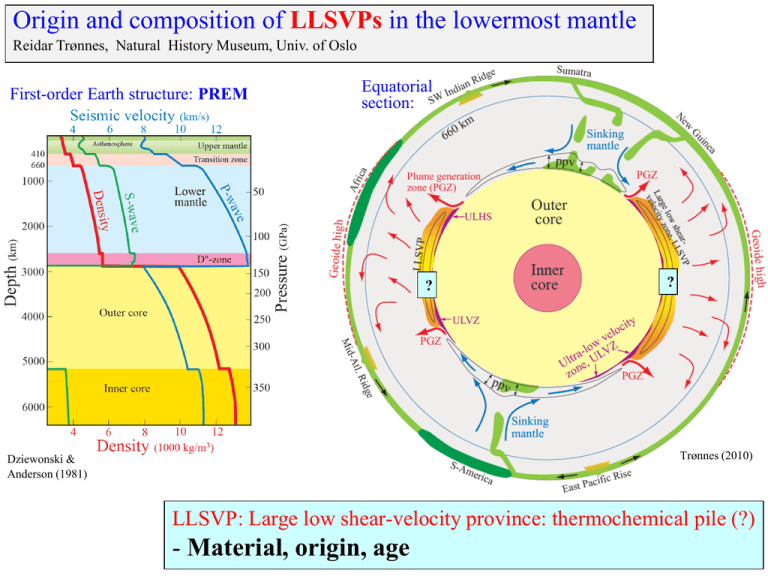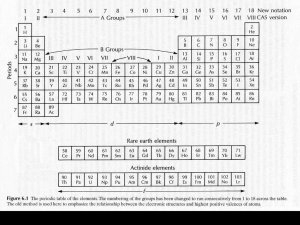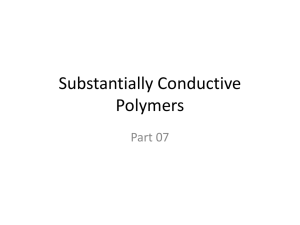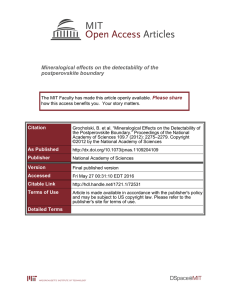Goldschm11-draft
advertisement

Origin and composition of LLSVPs in the lowermost mantle Reidar Trønnes, Natural History Museum, Univ. of Oslo First-order Earth structure: PREM Equatorial section: ? ? Trønnes (2010) Dziewonski & Anderson (1981) LLSVP: Large low shear-velocity province: thermochemical pile (?) - Material, origin, age Seismic tomography models Large vS-amplitudes at the top and bottom of the mantle Harvard model, Masters and Laske, website S-wave models, lowermost mantle (D”-zone) Two large anti-podal, slow provinces - LLSVP Africa – Pacific (near equator - 180º apart) Dziewonski et al. (2010, EPSL) The main, degree-2 velocity anomaly was recognized about 35 years ago ! e.g. Dziewonsky et al. (1977, JGR) Dziewonski & Anderson (1984, Am Sci) Earth’s rotation axis related to mantle mass distribution and geoid Steinberger and Torsvik (2010, GGG) Actual rotation axis Combined contributions: LLSVPs + shallow slab mass contributions Calculated rotation axis from LLSVP-contributions, only Comparison of seismic tomography (LLSVPs) and slab-sinking model at 2800 km depth Dziewonski et al. (2010, EPSL) Spherical harmonics modeling Power spectra Cumulative power spectra Tomographic models Slab model Degree 2 Degree 2 Tentative conclusions Lithgow-Bertelloni & Richards (1998, Rev. Geophys.) 1. The observed degree-2 pattern is only partly reproduced by calculated slab-accumulation 2. The LM-structure may thus be old ( > 300-500 Ma) Plume generation along the margins of LLSVPs: evidence from relocated LIPs SC Large igneous provinces (LIPs) - age span: 16-297 Ma - irregular distribution Paleogeographic relocation → LIPs cluster near LLSVP-margins - long-term stability - dense and hot SC Africa Pacific –3% slow Burke & Torsvik, 2004, EPSL Torsvik et al., 2006, GIJ Burke et al. 2007, EPSL Torsvik et al. 2008, EPSL Additional kimberlite and LIP data Torsvik et al. (2010, Nature) LLSVP-stability may exceed 540 Ma Seismological image of Plume Generation Zones (PGZ) S-wave model S-wave model NE part of Pacific LLSVP Samoa quakes, recorded in N-America Lay et al. (2006, Science) Double crossing of the pv-ppv-transition Large lateral variation horizontal flow (and PGZ) Mantle flow model Bin 1-3 D”-discontinuities Lay and Helmberger (1983, GJRAS): S-wave triplication: S, Scd and ScS (in certain areas, at least) The Scd and Scd2 may be ascribed to double-crossing of the post-perovskite boundary - large thermal gradient in the D” - large dp/dT-slope of phase bound. pv-ppv transition - wide phase loop: pv and ppv coexist through the entire D"-zone and -the Al2O3-component stabilizes pv and widens the phase loop Catalli et al. (2009, Nature) Possible rheological explanation for sharp D”-discontinuities (Amman et al. 2010) Strong alignment and dislocation creep in ppv at a ”critical” phase proportion (40-50% ?) With this model: - D”-discontinuities: rheological changes (steadily increasing ppv-fraction with depth) - High T may facilitate diffusion creep below the lower discontinuity. - Additionally: the lower discontinuity could also be caused by back-reaction to pv. But probably no ppv inside LLSVPs - hot and rich in basaltic material (?) Locally steep thermochemical pile margins Requirements: - moderate density contrast (2-5 %) - pile material: higher bulk modulus than ambient mantle Garnero & McNamara (2008, Science) High thermal conductivity and low thermal expansivity in the lowermost mantle may help to stabilize the thermochemical piles Possible LLSVP-material Basalt-rich - separated from subducted lithosphere - age: 3-0 Ga Perdotitic (or komatiitic) with elevated Fe/Mg-ratio - cumulates, deep-level partial melts - age: mainly Hadean Mantle mineralogy Irifune & Tsuchiya (2007, Treatise on Geophys.) Shim et al. (2011, this meeting) Density relations peridotite - basalt Irifune & Tsuchia, 2007, Treatise on Geophys. K0 (GPa) Mg-pv 230-260 (perid. is stiffer ?) Ca-pv 236 softest: ferroper. 158-152 (FeO-MgO) stiffest: silica 314-325 (stish. - aPbO2) K’: poorly constrained Basalt: pv, Ca-pv, SiO2, Al-phase high r, possibly higher K0 Peridotite: pv, fp, Ca-pv low r, possibly lower K0 Density contrast: 1-3% - sufficient ? Peridotite (or komatiite) with elevated Fe/Mg-ratios Origins: Magma ocean cumulates from late-stage, residual melts - crystallization near CMB - crystallization in TZ or UM, followed by density-driven sinking to CMB Deep-level Hadean melting in hot plumes at >300 km depth, followed by downward or upward migration to 410 km depth, crystallization, cooling and sinking to CMB (possible plume initiation by density overturn of cumulate sequences) Compared to ambient” peridotite: - Similar mineralogy (in D” mainly pv/ppv and fp) - Higher density (possibly higher than basalt) - Higher bulk modulus → LLSVP-requirements may easily be fulfilled Dense cumulates from crystallization of lower mantle magma ocean Depend on relative slopes of peridotite liquidus and melt isentropes z If melt adiabat intersects the curved liquidus here, the magma ocean will strart crystallizing in the middle Scenario with two magma ocean Labrosse et al (2007, Nature) Stixrude et al. (2009, Earth Planet. Sci. Lett.) Stage 1 Core Stage 2 Cumulates with lower Fe/Mg Cumulates with higher Fe/Mg Core Stage 3 Inner magma ocean: melt density > crystal density (pv, fp) (Fe/Mg)melt > (Fe/Mg)crystals Fe-rich cumulates starting point for thermochemical piles Core Sinking of solidified melts from 410 km depth melts formed in hot plumes at 300–900 km Suggested by: Lee et al. (2010, Nature) → Intermediate age span: Hadean-Archean (between scenarios 1 and 2) Based on: Zhang & Herzberg (1994, JGR) Tønnes & Frost (2002, EPSL) Ito et al. (2004, PEPI) Lee et al. (2010, Nature) Melt accumulation zone Solidified, thermally equilibrated melt sink to the CMB Unresolved issue: pseudo-invariant melt compositions at 20-30 GPa - liquidus phase variation can guide - systematic experimentation on a range of model compositions Further experiments with D.J. Frost, BGI-Bayreuth Other important tasks Better data on phase transitions and EoS in basaltic material Na-Al-phase (15-20 %): Ca-ferrite to Ca-titanite structure (??) Silica phase (10-15 %): CaCl2- to aPbO2-structure - p-T-condition of transition, including Clapeyron slope - compositional relations (silica-phases may contain up to 12% Al2O3) Possible silica analogue compositions : TiO2, ZrO2, CaCl2 and aPbO2 (at var. T) For all minerals, better data on: - thermal conductivity, incl. radiative conductivity - Fe-spin transitions (in the minerals pv, ppv and fp) - thermal expansivity (and EoS in general) - mechanical propertis, diffusivity, deformation style (viscocity) Geochemistry The relations of ULVZs and LLSVPs with possible long-lived, enriched (fertile) mantle reservoirs Large thermal boundary layer at CMB Mantle-core mixing is prevented by contrasts in density (5500 - 9900 kg/m3) and viscosity Large T-increase → viscosity decrease in the D” CMB From: Steinberger and Calderwood (2006, GJI) Thermochemical piles (LLSVPs) 3 possible origins – 3 different age scenarios Independant evidence for long-term stability: e.g. several studies by Torsvik et al., Dziewonsky et al. (2010, EPSL) Mechanism 1: Segregation and accumulation of basaltic parts of subducted slabs → slow growth over most of Earth history The plume generation zone: density-driven separation basalt – peridotite Trønnes (2010, Mineral. Petrol.) In spite of viscocity decrease in D”: The rheology of the mantle imposes the convective and thermal regime of the core Terrestrial planets with liquid cores: ”Mantle is the master - core is the slave” (Dave Stevenson, Caltech) Crystal structures Pv: HIGH entropy Post-pv: LOW entropy pv-ppv transition has large, positive dp/dT-slope MgSiO3 (Murakami et al. 2004) Phase boundary: not well constrained by DAC-experiments Analogue system: CaIrO3 DFT-model of pv-ppv in CaIrO3 Stølen & Trønnes (2007, PEPI) dp/dT = 19 MPa/K DK: negative (reaction: pv→ppv) DG: positive (Dr: negative) Similar DFT-results for MgSiO3 (e.g. Wookey et al. 2005, Nature) vs2 = G/r vf2 = K/r (bulk sound speed) vp2 = (K + 4/3*G)/r Consistent with the anti-correlated vS and vF Compressibility of pv and ppv, CaIrO3 Experiments: Boffa-Ballaran et al. 2007, Am Min. DFT: Stølen & Trønnes 2007, PEPI So the D"-discontinuities disappear !? But then: Amman et al. (2010, Nature) DFT-computation of diffusion rates: pv, fp and ppv Step 1: Testing of agreement between existing experimental data and computations for pv and fp. Result: good agreement Step 2: Computation of diffusion rates for ppv Result: strongly anisotropic diffusion in ppv with fast diffusion along a-axis low diffusion creep viscosity along a-axis Most of the lower mantle - no seismic anisotropy, small grain size and low stress (Solomatov et al. 2002) - high viscosity diffusion creep is likely D”: - cold areas: strong seismic anisotropy (high VSH) - low viscosity extensive deformation and LPO is likely deformation-related dislocation creep is likely CMB Steinberger and Calderwood (2006, GJI) Ammann et al. (2010, Nature), Hunt et al. (2009, Nature Geoscience): For dislocation creep: ppv may be 4 orders of magnitude weaker than pv Rheology changes dramatically at critical phase fraction of 30-50% ppv New model for D"-discontinuities With this model: - D”-discontinuities: rheological changes (steadily increasing ppv-fraction with depth) - High T may facilitate diffusion creep below the lower discontinuity. - Additionally: the lower discontinuity could also be caused by back-reaction to pv. Structure and dynamics of D” - Basalt is denser and stiffer (higher K0) than peridotite (consistent with LLSVPs and PGZs) - Deformation / LPO of ppv at critical phase fraction may eplain the seismic D"-disc. in low-T areas Important unresolved issue: Seismic observation of discontinuities inside the hot LLSVPs (thermo-chemical piles, basaltic?) cannot bed due to the pv-ppv-transition (relative stabilization of pv by the FeAlO3-component precludes this) T Could other phase transitions in basalt-rich material be responsible ? - Possible candidate: CaCl2- to aPbO2-structure of SiO2 - Do we know the Clapeyron slope of this transition ? - Ohta et al. (2008, EPSL) indicate positive dp/dT, but this is not well established - Positive slope could explain a double-crossing scenario p CMB core Earth dynamics – a modified working hypothesis Modified from Trønnes (2009/10, Mineral. Petrol.) ? ? The plume generation zone: density-driven separation of basalt and peridotite Schematic equatorial section CaIrO3-based analogues (for MgSiO3) - space group match: pv: Pbnm, ppv: Cmcm - phase transition at 1-3 GPa and 1400-1600 ºC - both phases are quenchable to ambient conditions, enabling single-crystal XRD: single-crystal structure refinement, DAC-compressibility, thermal expansivity - bulk and shear moduli changes for the pv-ppv-transition correspond to MgSiO3-based comp. - deformation mechanisms and slip systems may be similar to D” and MgSiO3-based comp. E.g. Walte et al. (2009), Hunt et al. (2009), Amman et al. (2010) But also contradictory indications for slip mechanisms, e.g. Miyagi et al. (2010) Substitutions in CaIrO3-based systems (possible studies of phase relations, mineral physics and deformation) Divalent A-site subsitutions for Ca: Sr, Ba - corresponding to Mg-Fe-substitutions Trivalent A- and B-site substitutions for Ca and Ir: In, Sc, Y - corresponding to end members: Al2O3, FeAlO3, MgAlO2.5 Large T-gradients in D” large positive dp/dT-slope of pv to ppv transition re-stabilization of pv near CMB the "double-crossing" scenario of Hernlund et al (2005, Nature) Thermal gradients S-wave speed Another characteristic feature: anti-correlated vS and vF










